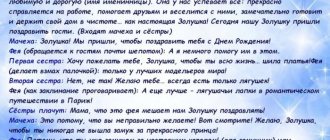In 1918 the calendar changed. Since then, we have spoken in some cases “according to the old style” and “according to the new style.” The difference between these styles is 13 days. Using the example of the New Year, we see that according to the new style we celebrate it on January 1, and before it was celebrated on January 14. However, our people, who love to relax and walk with all their hearts, celebrate the New Year twice, on the night of December 31 to January 1 and on the night of January 13 to January 14. In this article we will present you with interesting scenarios, skits and songs that can be used to celebrate the Old New Year.
Old New Year script for adults
For adults, you can organize an interesting feast, in which you can hold competitions and other entertaining games dedicated to the Old New Year:
New Year as usual
Guests are divided into pairs. Each pair takes out a forfeit from the bag. Each fanta indicates a specific couple from history, for example, Romeo and Juliet, Napoleon and Josephine, Cleopatra and Mark Antony, and so on. Each pair then takes turns speaking using characteristic words and phrases. You need to try so that the other guests guess as quickly as possible what kind of couple is celebrating the Old New Year. Of course, you can't use each other's names. For example: - Honey, don’t buy such a tall spruce again. - Darling, but she's not too tall. - And for me it’s high. I had to set up a stepladder to hang the star. Moreover, he left his bicorne hat on pins and needles, it got caught... (Napoleon and Josephine celebrate the Old New Year). The couple whose characters the guests guess the fastest will be the winner.
Old New Year - poems
Old New Year fortune telling
As you know, on the Old New Year it is customary to guess and believe in fortune predictions. The guests sit in a circle. Each guest will draw a prediction for a neighbor. Starting with the first participant, each guest takes out a phantom from the bag, in which a certain prediction is written, for example, “You will definitely fly by plane to Italy” or “You will find a treasure” and so on. So, the first guest takes out the forfeit, goes to the easel, takes a felt-tip pen and draws his prediction for the second guest. He draws, showing all his talents, until the guest pronounces the prediction verbatim. As soon as the second guest guesses his prediction, he takes out the forfeit and goes to the easel to draw a prediction for the third guest. The most talented participants will receive prizes for their creative drawings and cheerful emotions.
Old New Year - riddles
You can include these riddles in your script or prepare them just in case there is some kind of technical hitch during the event:
Lucky - unlucky
Guests are divided into two equal teams, approximately 3-5 people each. The first participants come out. A minute is timed for them, and the participants themselves take turns taking one forfeit with words from the plate and showing them to their teams. The first one shows, his team guesses. As soon as she guessed right, she shows the second one. The participant on whom the minute stops loses and the point is counted to the opposing team. Then the second team members come out. The minute is also timed for them. At the end of the game, the team with the most points wins. It is better to take words for forfeits from New Year's themes, for example, presidential greetings, New Year's tree, star, snowman, mittens, icicle, and so on.
Old New Year - remade songs
Option #1
Option No. 2
Option #3
Option No. 4
Option #5
Old New Year - competitions
- " Baba Yaga ". All those present are divided into 2 teams. The competition will be held on the principle of a relay race. Each participant must run around the chair at speed with a bucket on one leg and holding a mop in his hands and come back. The visiting team that can outpace the opponent in speed and originality will win.
- " The best burglar ." Several people are selected, each is given a bunch of keys and one padlock. The task of each participant is to find a suitable key in the bunch as quickly as possible and open the lock.
- " Haute couture ". You need to form several pairs. Ideally, these will be men and women (they can be in a relationship). They are deprived of sight, blindfolded with some thick dark cloth, and given a bag of things. They must put everything they feel correctly on each other, and this must be done quickly. The couple that finishes it the fastest will be the winner. Usually all this happens very funny, especially for those who are observers.
- " Ice ". 2 teams are formed from the guests. Each person is given an ice cube that needs to be melted by simply passing it from hand to hand. The team that can melt the ice faster in this way will be the winner. You cannot melt an ice cube by breathing or in any other way.
- " Congratulations in alphabetical order ." The presenter invites several people to participate. He tells everyone the letter with which he should start saying congratulations. For example, the letter "A". The participant can say: “May everyone be happy in the new year!”
The Old New Year, of course, is no longer as joyful as the main holiday with which the year begins, because everyone is already exhausted from a series of feasts. We wish you that your holiday will be a success and bring you only joy and a great mood!
Scenario of an extracurricular event for younger schoolchildren on the topic: Old New Year
“History and traditions of celebrating the Old New Year” - an educational game program for primary schoolchildren
Old New Year.
Scenario for younger schoolchildren Author: Valentina Petrovna Churepkina, teacher of the Regional Children's Sanatorium for Tuberculosis Patients, Berezovsky, Barzas, Kemerovo Region.
On the night of January 13-14, Russians celebrate the Old New Year - a holiday that is incomprehensible to many foreigners. No one can really say - how does the Old New Year differ from the traditional, familiar New Year? Of course, from the outside it would seem that the issue is only a discrepancy in dates. However, we all treat the Old New Year as a completely independent holiday that can prolong the charm of the New Year. The arrival of the Old New Year will bring us bright magic! The glorious finale of the New Year's celebrations You won't get tired of celebrating joyfully! There is a reason to please your loved ones again - We can give gifts, congratulate... A chance to show your feelings again, Celebrate a family evening in love! Author: Ekaterina Shelygina Description: This material will be useful to primary school teachers, preschool teachers, as well as children and parents who are interested in the history, traditions and customs of Russian folk holidays and strive to preserve what is valuable that remains of what has been unfairly forgotten. Goal: appeal to the spiritual and moral traditions and values of one’s people. Objectives: to introduce the Russian folk holiday Vasiliev Day, traditions, customs; to form cognitive needs and interests, activity; enrich the child’s experience, saturate this experience with new knowledge and information about the environment, expand and deepen the opportunities for the emergence and consolidation of stable cognitive interests; to cultivate a respectful attitude towards the way of life, way of life, and customs of our ancestors, to strive to preserve what is valuable that remains from what was unjustly forgotten; awaken an emotional attitude towards life. Preliminary work: the day before, the children are given the task: find out the recipe for cookies from their grandmothers or friends and bake them in the shape of a symbol of the coming New Year; instruct the creative group to cut out beautiful snowflakes from paper; ask the children to take with them all sorts of small souvenirs to use for general play. Material: elegant herringbone; beautiful snowflakes cut out of paper; a bowl of dumplings; all kinds of souvenirs and sweets on a tray. Progress: Teacher: Hello, dear guys!
Winter is the richest time of the year with holidays. What winter holidays do you know? (children’s answers) “From the history of the Old New Year holiday”
Teacher: One of them is New Year’s Eve: Vasily’s Day.
It turns out that in Ancient Rus' this day was also celebrated annually, but not as New or Old Year, but as Vasily’s Day. It was named in honor of Basil the Great, the holy Archbishop of Caesarea, deeply revered by Christians, or, as people call it, the Old New Year. So today, together with you and the guys, we will celebrate, just like in Rus', Vasily’s Day or the Old New Year. It is celebrated on the night from the thirteenth to the fourteenth of January. “Where they celebrate the Old New Year”
Teacher: Look at our Christmas tree. I hung unusual snowflakes on it. Now those who wish will be able to remove snowflakes from the Christmas tree, and on each snowflake the country where the Old New Year is celebrated is written. Together with the Russians, the Old New Year is also celebrated: Children remove one snowflake from the Christmas tree and name the country: in Ukraine, Belarus, Moldova, Armenia, Kazakhstan, Georgia, Macedonia, Serbia and Montenegro, in some parts of Switzerland. Teacher: The reasons are the same - either local churches continue to live according to the Julian calendar, or the celebration of the Old New Year is a tribute to traditions caused by popular rejection of the transition of chronology from the old to the new style.
“Traditions for the Old New Year”
Teacher: According to the ancient tradition, on this day it was customary to generously set the table. Early in the morning it was customary to cook Vasiliev’s porridge and watch how it was prepared. If the porridge escapes from the pan, there will be trouble. It was considered a bad omen if a pot or pan in which porridge was cooked cracked. If the porridge is a success, you need to eat it clean. And to prevent any of the bad omens from coming true, one should throw the porridge along with the cracked pot, preferably into an ice hole. Another tradition is to scatter grains of wheat on the floor, calling for a fruitful year. In the old days, children did this with songs and sayings, and the mistress of the house collected these grains, put them in a clay pot or in a canvas bag and stored them until sowing. We, of course, are modern people, and few of us sow wheat, but we expect fertility from the coming year in the sense of money and pleasant events. Therefore, we can scatter, collect and store grains in the same way. And instead of sowing, you can easily cook porridge from these grains and eat them before next year. On the old New Year, there is a tradition of caroling - dressing up in animal skins or simply beyond recognition, walking from house to house, singing, reading poetry, earning pies, sweets and other delicacies. Teacher: Today, for the old New Year, few people cook porridge. But the number of people who want to celebrate this day is growing every year. Traditions instruct us to celebrate the old New Year with pomp, be sure to set a rich table and gather around it all those whom we love and whom we wish happiness. It is not necessary to give gifts on this day, however, it is still worth preparing small surprises for relatives and friends - there is never too much joy. Teacher: On the eve of the “Old New Year”, January thirteenth - January 13th - a generous evening.
One of the traditions in Russia on the night of the Old New Year is to sculpt and cook dumplings. Dumplings were most often made with cottage cheese, but a few were made with flour, salt, a coin, or left empty. If you get a dumpling stuffed with flour, life will be rich, but hard; with salt – bitter; empty dumpling - empty life; with a coin - happy and long. Game "Dumplings with a surprise"
Teacher (draws the children’s attention to a bowl of dumplings): These are not just dumplings, but dumplings with a surprise. Surprises may be different, but this does not make the tradition lose its charm. Let's each take a dumpling and see what awaits him next year? (Children take 1 dumpling and see what’s in it: beans - for children, a button - for new clothes, sugar - sweet life, pepper - to live with pepper, thread - for the road (travel), coin - for money or a gift, peppercorn - to unexpected joy, etc.) Teacher: This holiday is cozy and calm.
He is not characterized by the fuss that inevitably accompanies a regular New Year. On such an evening, after a meal, it’s a good idea to play some calm family game, for example, Russian Lotto. And now I propose to play ancient games. And one of them is called “Okhlopok”. Game "Okhlopok"
Everyone stands in a circle and throws a piece of cotton wool up (you need to fluff it up). The goal is to prevent the cotton wool from falling. The player near whom the clapper falls pays a forfeit (sings a song, crows, reads a poem, etc.). Therefore, everyone is trying to quickly blow the cotton away from themselves to their neighbor. The cotton flies either higher or lower, so the players either squat, then stand on tiptoe, or bend over. Usually the result is a very funny picture.
Game "Even-odd"
Prepare small surprises in advance - candies, stickers, small calendars or pictures, badges or postcards, toys, pencils, cookies, waffles, etc.
So, having collected all the surprises brought and collected, we begin to divide them into piles. The piles will be different - some piles will have an even number of gifts, and some will have an odd number. The piles are covered with opaque scarves on top. This is an old version. And now we can simply put the gifts in opaque bags - and then there is no need for scarves. Teacher: Let's start playing gifts.
The first player points to one of the piles and asks: “Even or odd?” The second player answers either “even” or “odd”. Let's count the gifts in this pile. If the second player guessed right, then he takes a bunch of gifts and asks the third player (along the chain): “Even or odd?” The third one answers, etc. New Year's quiz “What? Where? When?"
When conducting a quiz, divide everyone present into two groups, and borrow the methodology from your favorite game television programs, having thought in advance about the scoring system - snowflakes, snowmen.
Teacher: Answer questions related to the New Year celebration. Get snowflakes and snowmen for correct answers. Question 1: Which ancient Russian city is considered the birthplace of Father Frost? (Veliky Ustyug, Volgograd region.) Question 2: Which Russian city is the historical birthplace of the Snow Maiden? (Kostroma. In Kostroma, the Snow Maiden has both a tower and a living room, where she cordially receives and entertains her guests of any age.) Question 3: Representatives of what profession in European countries were it customary to touch “for good luck” on New Year’s Day? (To the chimney sweeps.) Question 4: What is the name of the Russian ancient, but ageless dance at the New Year's tree? (Round dance.) Question 5: In Japan, the arrival of the New Year is announced by 108 strikes of the bell; in the UK, New Year's midnight is struck by London's Big Ben clock. But in Russia? (Moscow Kremlin chimes.) Question 6: In Russia, when the whole family gathered at the New Year's table, the children tied the table legs with a bast rope. What did this New Year's custom symbolize? (This meant that the family would be strong in the coming year and should not be separated.) Question 7: How can you explain the meaning of the tradition widespread in Germany, when those celebrating the New Year, before striking the clock, climb onto chairs to “jump” into the coming year? (This is explained by the symbolic desire to “not leave a legacy” in the coming year, leaving in the past everything bad that could stick even to the soles of shoes.) Question 8: What is the name of Santa Claus’ “magic wand”? (Staff.) Question 9: An exclusively Russian character accompanying Father Frost. This is... (Snow Maiden.) Question 10: In Japan, the New Year is celebrated with 108 rings of the bell in the temple, symbolizing cleansing from six human vices, each with 18 shades (6 x 18 = 108, is it clear where this number comes from?). Now name these six vices that you shouldn’t enter the coming year with? (Greed, anger, stupidity, frivolity, greed, indecision.) Question 11: Why didn’t the future poet Pushkin have a New Year’s tree in his childhood? (In Russia, the Christmas tree began to be used as a New Year's tree only from the middle of the 19th century.) Question 12: Why do Italians walk in the middle of the pavement on the evening of December 31? (They are afraid to walk along the edges of the pavement for safety reasons, since Italians throw old rubbish and furniture out of windows on New Year's Eve.) Question 13: In which country, during New Year's street processions - the most exciting part of the holiday - thousands of lanterns are lit to illuminate their way into the New Year? (In China.) Question 14: Nickname of Santa Claus. (Red nose.) Question 15: This New Year's grandfather has a long-brimmed red fur coat, a boyar hat, a thick white beard and a long staff in his hands. Whose Santa Claus is this? (Russian Santa Claus.) Summing up the game: the teacher counts which team has more points - snowflakes, snowmen.
Offers children to exchange them for prizes. "Symbol of the New Year"
Teacher: 2015 is the year of the Goat or Sheep.
And today, in honor of the symbol of the New Year, in order to appease it, we make a small lamb or goat from salt dough, and may they bring you good luck this year and remain with you as a memory of our meeting (pieces of salt dough are handed out, and the guys make symbols of the New Year). “Lambs on the table”
Teacher: Also for the Old New Year they baked cookies in the shape of animals, birds and other figures. You and I also followed this ancient custom and baked delicious cookies according to the recipes of our grandmothers and friends.
The teacher brings in a tray with delicious cookies (which the children made with their own hands using technology from the teacher or baked at home according to grandmothers’ recipes). One of the conditions: the cookies must display the symbol of the coming New Year.
The teacher invites the children to a tea party. During tea drinking, children exchange recipes for making cookies, have a heart-to-heart conversation on the topic of caroling, Christmas fortune-telling, and share traditions of celebrating the Old New Year in the family. Summing up: We had a lot of fun and learned a lot about the glorious holiday. Goodbye, Old New Year, see you again!
We recommend watching:
New Year's lantern made of cardboard. Master class with step-by-step photos DIY snowman Park in New Year New Year in the park
Similar articles:
New Year's poems for children
New Year's riddles for children
Happy New Year
Happy New Year according to the eastern horoscope
Happy New Year greetings for friends and girlfriends











